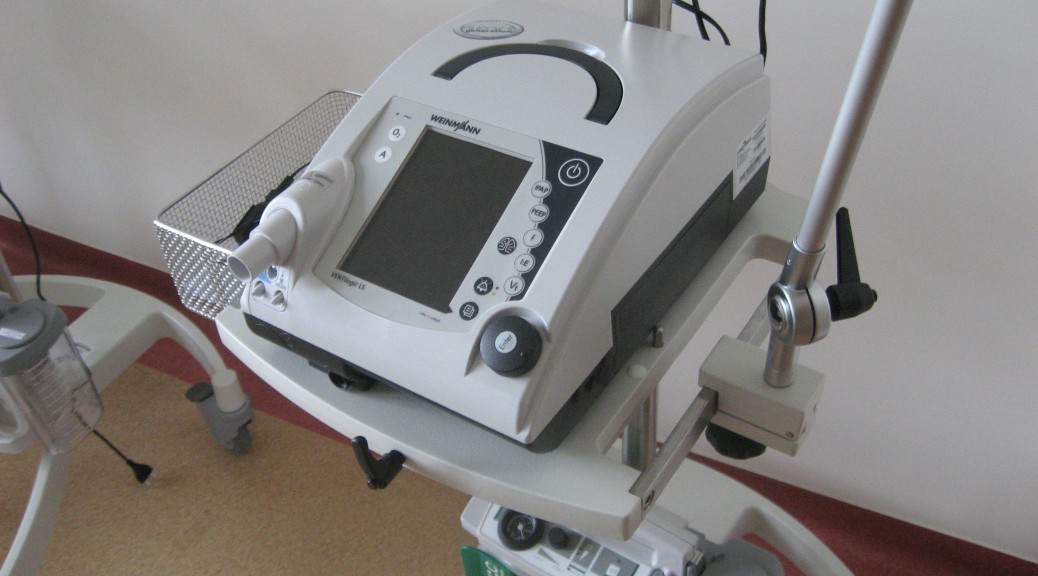Respirator można inaczej nazwać sztucznym płucem. Do czego służą nasze płuca to na pewno każdy wie – do wymiany gazowej, dzięki której dostarczamy do naszych komórek potrzebny tlen i usuwamy z nich zbędny dwutlenek węgla. W wyniku tego procesu pozyskujemy bardzo potrzebną energię. Respirator jest więc urządzeniem medycznym, które wspomaga lub zastępuje mięśnie oddechowe pacjenta w mechanicznym procesie oddychania, w sytuacjach ustania czynności oddechowej, np. w wyniku urazu, choroby, lub zastosowania niektórych leków działających na układ nerwowy. Może też ułatwiać oddychanie, gdy pacjent oddycha samodzielnie, lecz czynność ta jest utrudniona i niewystarczająca. Tyle na ten temat w wielkim skrócie.
Typów i rodzajów respiratorów jest bardzo dużo – są mniej lub bardziej wyposażone w różne funkcje wspomagające czy monitorujące stan chorego, mniejsze i większe, tańsze i droższe, ale ogólnie – im bardziej skomplikowany i posiadający więcej funkcji, tym jest droższy, ale jednocześnie mający szersze zastosowanie w szpitalach posiadających oddziały intensywnej terapii i anestezjologii – jak nasz.
Jakie urządzenia potrzebujemy w Szpitalu Pomocy Maltańskiej w Barczewie?
A medical ventilator can in other words be called an artificial lung. Everyone knows what we have lungs for: the gas exchange through which we supply our body cells with the oxygen they need, and remove the waste carbon dioxide. As a result of this process we obtain much needed energy. A ventilator is a medical machine which assists or takes over from the respiratory muscles in the process of mechanical ventilation, in situations where spontaneous breathing has ceased (for example as a result of trauma or illness, or because of certain medications which influence the nervous system). It can also facilitate breathing when the patient can breathe alone but the function is impaired and inefficient. That would be the long and short of it.
There are very many different types of ventilators. They can have various additional functions which support and monitor the patient’s condition. They come in all shapes and sizes as well as varying prices, but in general the more complex the machine, the more expensive it is, but at the same time the more useful for hospitals with intensive care and anaesthesiology units – like ours.
What kind of machines are needed then in our Maltese Assistance Hospital in Barczewo?
Na dzień dzisiejszy dysponujemy w zakładzie kilkunastoma respiratorami – część z nich jest „starej daty”, ale są oczywiście sprawne. Trzeba pamiętać, że nasze respiratory pracują całą dobę, bez przerwy – a one też się zużywają. „Dysponujemy” oznacza, że nie wszystkie są nasze, dzierżawimy je, a optymalnie byłoby posiadać cały, potrzebny komplet.
Jest jeszcze jedna kwestia z tym związana – zapotrzebowanie na tego rodzaju opiekę nad pacjentem przewlekle chorym wymagającym zastosowania respiratora w zakładzie opiekuńczym stale rośnie, co widać w naszej działalności, gdyż zwiększamy ciągle ilość łóżek dla takich pacjentów.
Panie Tomku! Cały Szpital Maltański w Barczewie jest z Panem i trzyma kciuki!
At present, we have at our disposal over a dozen ventilators. Some of them are already quite old, but they’re all functional. One has to bear in mind the fact that our ventilators work around the clock, non-stop – and they are subject to wear. “At our disposal” means that they aren’t all ours. We lease them, and it would be ideal to own the whole repertory.
There’s one more thing that is directly related to it: the demand for this kind of care in our facility, with long-term patients requiring mechanical ventilation, keeps on growing, which becomes visible as we constantly increase the number of beds for such patients.
Dear Tomasz! The staff of the Maltese Assistance Hospital in Barczewo are keeping our fingers crossed for you!
Edyta Skolmowska – Szpital w Barczewie


